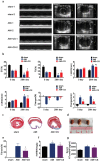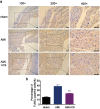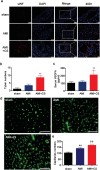Ion Therapy: A Novel Strategy for Acute Myocardial Infarction
- PMID: 30643722
- PMCID: PMC6325593
- DOI: 10.1002/advs.201801260
Ion Therapy: A Novel Strategy for Acute Myocardial Infarction
Erratum in
-
Erratum: Ion Therapy: A Novel Strategy for Acute Myocardial Infarction.Adv Sci (Weinh). 2020 May 20;7(10):2000544. doi: 10.1002/advs.202000544. eCollection 2020 May. Adv Sci (Weinh). 2020. PMID: 32440490 Free PMC article.
Abstract
Although numerous therapies are widely applied clinically and stem cells and/or biomaterial based in situ implantations have achieved some effects, few of these have observed robust myocardial regeneration. The beneficial effects on cardiac function and structure are largely acting through paracrine signaling, which preserve the border-zone around the infarction, reduce apoptosis, blunt adverse remodeling, and promote angiogenesis. Ionic extracts from biomaterials have been proven to stimulate paracrine effects and promote cell-cell communications. Here, the paracrine stimulatory function of bioactive ions derived from biomaterials is integrated into the clinical concept of administration and proposed "ion therapy" as a novel strategy for myocardial infarction. In vitro, silicon- enriched ion extracts significantly increase cardiomyocyte viability and promote cell-cell communications, thus stimulating vascular formation via a paracrine effect under glucose/oxygen deprived conditions. In vivo, by intravenous injection, the bioactive silicon ions act as "diplomats" and promote crosstalk in myocardial cells, stimulate angiogenesis, and improve cardiac function post-myocardial infarction.
Keywords: acute myocardial infarction; bioactive ions; therapy.
Figures











Similar articles
-
Intravenous injection of allogeneic umbilical cord-derived multipotent mesenchymal stromal cells reduces the infarct area and ameliorates cardiac function in a porcine model of acute myocardial infarction.Stem Cell Res Ther. 2018 May 11;9(1):129. doi: 10.1186/s13287-018-0888-z. Stem Cell Res Ther. 2018. PMID: 29751831 Free PMC article.
-
Externally Applied Static Magnetic Field Enhances Cardiac Retention and Functional Benefit of Magnetically Iron-Labeled Adipose-Derived Stem Cells in Infarcted Hearts.Stem Cells Transl Med. 2016 Oct;5(10):1380-1393. doi: 10.5966/sctm.2015-0220. Epub 2016 Jul 8. Stem Cells Transl Med. 2016. PMID: 27400797 Free PMC article.
-
C-Kit Positive Cardiac Stem Cells and Bone Marrow-Derived Mesenchymal Stem Cells Synergistically Enhance Angiogenesis and Improve Cardiac Function After Myocardial Infarction in a Paracrine Manner.J Card Fail. 2017 May;23(5):403-415. doi: 10.1016/j.cardfail.2017.03.002. Epub 2017 Mar 8. J Card Fail. 2017. PMID: 28284757
-
How Biomaterials Can Influence Various Cell Types in the Repair and Regeneration of the Heart after Myocardial Infarction.Front Bioeng Biotechnol. 2016 Jul 18;4:62. doi: 10.3389/fbioe.2016.00062. eCollection 2016. Front Bioeng Biotechnol. 2016. PMID: 27486578 Free PMC article. Review.
-
Acute Myocardial Infarction, Cardioprotection, and Muse Cells.Adv Exp Med Biol. 2018;1103:153-166. doi: 10.1007/978-4-431-56847-6_8. Adv Exp Med Biol. 2018. PMID: 30484228 Review.
Cited by
-
Ion therapy of pulmonary fibrosis by inhalation of ionic solution derived from silicate bioceramics.Bioact Mater. 2021 Mar 10;6(10):3194-3206. doi: 10.1016/j.bioactmat.2021.02.013. eCollection 2021 Oct. Bioact Mater. 2021. PMID: 33778199 Free PMC article.
-
Design of a biofluid-absorbing bioactive sandwich-structured Zn-Si bioceramic composite wound dressing for hair follicle regeneration and skin burn wound healing.Bioact Mater. 2020 Dec 16;6(7):1910-1920. doi: 10.1016/j.bioactmat.2020.12.006. eCollection 2021 Jul. Bioact Mater. 2020. PMID: 33364530 Free PMC article.
-
Trends of calcium silicate biomaterials in medical research and applications: A bibliometric analysis from 1990 to 2020.Front Pharmacol. 2022 Oct 14;13:991377. doi: 10.3389/fphar.2022.991377. eCollection 2022. Front Pharmacol. 2022. PMID: 36313285 Free PMC article.
-
Bioglass could increase cell membrane fluidity with ion products to develop its bioactivity.Cell Prolif. 2020 Nov;53(11):e12906. doi: 10.1111/cpr.12906. Epub 2020 Oct 11. Cell Prolif. 2020. PMID: 33043500 Free PMC article.
-
Silicate-based therapy for inflammatory dilated cardiomyopathy by inhibiting the vicious cycle of immune inflammation via FOXO signaling.Sci Adv. 2025 Apr 11;11(15):eadr7208. doi: 10.1126/sciadv.adr7208. Epub 2025 Apr 9. Sci Adv. 2025. PMID: 40203118 Free PMC article.
References
-
- Roger V. L., Go A. S., Lloyd‐Jones D. M., Adams R. J., Berry J. D., Brown T. M., Carnethon M. R., Dai S., De Simone G., Ford E. S., Fox C. S., Fullerton H. J., Gillespie C., Greenlund K. J., Hailpern S. M., Heit J. A., Ho P. M., Howard V. J., Kissela B. M., Kittner S. J., Lackland D. T., Lichtman J. H., Lisabeth L. D., Makuc D. M., Marcus G. M., Marelli A., Matchar D. B., Mcdermott M. M., Meigs J. B., Moy C. S., Mozaffarian D., Mussolino M. E., Nichol G., Paynter N. P., Rosamond W. D., Sorlie P. D., Stafford R. S., Turan T. N., Turner M. B., Wong N. D., Wylie‐Rosett J., American Heart Association Statistics Committee and Stroke Statistics Subcommittee , Circulation 2011, 123, e18. - PubMed
-
- Benjamin E. J., Virani S. S., Callaway C. W., Chamberlain A. M., Chang A. R., Cheng S., Chiuve S. E., Cushman M., Delling F. N., Deo R., De Ferranti S. D., Ferguson J. F., Fornage M., Gillespie C., Isasi C. R., Jimenez M. C., Jordan L. C., Judd S. E., Lackland D., Lichtman J. H., Lisabeth L., Liu S., Longenecker C. T., Lutsey P. L., Mackey J. S., Matchar D. B., Matsushita K., Mussolino M. E., Nasir K., O'flaherty M., Palaniappan L. P., Pandey A., Pandey D. K., Reeves M. J., Ritchey M. D., Rodriguez C. J., Roth G. A., Rosamond W. D., Sampson U. K. A., Satou G. M., Shah S. H., Spartano N. L., Tirschwell D. L., Tsao C. W., Voeks J. H., Willey J. Z., Wilkins J. T., Wu J. H., Alger H. M., Wong S. S., Muntner P., American Heart Association Council on Epidemiology and Prevention Statistics Committee and Stroke Statistics Subcommittee , Circulation 2018, 137, e67. - PubMed
-
- Heldman A. W., Difede D. L., Fishman J. E., Zambrano J. P., Trachtenberg B. H., Karantalis V., Mushtaq M., Williams A. R., Suncion V. Y., Mcniece I. K., Ghersin E., Soto V., Lopera G., Miki R., Willens H., Hendel R., Mitrani R., Pattany P., Feigenbaum G., Oskouei B., Byrnes J., Lowery M. H., Sierra J., Pujol M. V., Delgado C., Gonzalez P. J., Rodriguez J. E., Bagno L. L., Rouy D., Altman P., Foo C. W., Da Silva J., Anderson E., Schwarz R., Mendizabal A., Hare J. M., JAMA 2014, 311, 62. - PMC - PubMed
-
- Segers V. F., Lee R. T., Circ. Res. 2011, 109, 910. - PubMed
LinkOut - more resources
Full Text Sources
